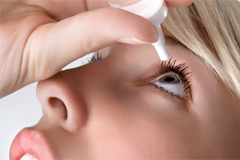Dry Eye Management
Dry Eye Syndrome
 Dry eye occurs when the eyes aren’t sufficiently moisturized, leading to itching, redness and pain from dry spots on the surface of the eye. The eyes may become dry and irritated because the tear glands don’t produce enough tears, or because the tears themselves have a chemical imbalance. People usually begin experiencing dry eye symptoms as they age, but the condition can also result from certain medications, conditions or injuries. Contact lens wear and computer use can exacerbate a dry eye. Dry eye is not only painful, it can also damage the eye’s tissues and impair vision.
Dry eye occurs when the eyes aren’t sufficiently moisturized, leading to itching, redness and pain from dry spots on the surface of the eye. The eyes may become dry and irritated because the tear glands don’t produce enough tears, or because the tears themselves have a chemical imbalance. People usually begin experiencing dry eye symptoms as they age, but the condition can also result from certain medications, conditions or injuries. Contact lens wear and computer use can exacerbate a dry eye. Dry eye is not only painful, it can also damage the eye’s tissues and impair vision.
Dry eye syndrome is initially treated with over-the-counter artificial tears (avoid using any product that says, “redness reliever”). When more frequent tear use is required to relieve symptoms, preservative free tears can be used. These come in individual vials and should be considered when tears are needed more than 4 times a day as the preservative in bottled tears may irritate the eyes even if the product says that the preservative in the bottled tear “dissolves on contact”. Some patients will benefit from having either a dissolvable or non-dissolvable plug placed in the tear drainage system. This essentially “backs up your plumbing” and allows the tears that are made or placed in the eye to last longer before going down the unblocked drain. (There are 2 drains per eye and generally only the lower one is blocked). Ask your doctor if you may benefit from this 30 second painless office procedure.
We also may be able to treat dry eyes nutritionally. There are many studies being conducted to help us learn more about the relationship between vitamins, minerals and antioxidants and eye health. So far, there have been promising findings associating Omega-3 fatty acids with a reduction of dry eye symptoms. Eating foods such as walnuts and coldwater fish like herring and mackerel that are rich in Omega-3 fatty acids or taking a supplement has been shown to lower the risk of developing dry eye syndrome. Researchers are not sure why, but it may be that they increase tear production or act as anti-inflammatories within the body.
Restasis®
 RESTASIS® Ophthalmic Emulsion is the only prescription eye drop available to treat chronic dry eye caused by low tear production. Made by Allergan, RESTASIS® drops increase tear production so the eyes are better moisturized and less painful. Two drops a day in each affected eye – one drop in the morning and one at night – is all it takes. According to Allergan, patients who use RESTASIS® report a noticeable increase in tear production, as opposed to those using steroid drops or tear duct (punctal) plugs.
RESTASIS® Ophthalmic Emulsion is the only prescription eye drop available to treat chronic dry eye caused by low tear production. Made by Allergan, RESTASIS® drops increase tear production so the eyes are better moisturized and less painful. Two drops a day in each affected eye – one drop in the morning and one at night – is all it takes. According to Allergan, patients who use RESTASIS® report a noticeable increase in tear production, as opposed to those using steroid drops or tear duct (punctal) plugs.
Xiidra®
Xiidra is a prescription eye drop used to treat the signs and symptoms of dry eye disease.
Do not use Xiidra if you are allergic to any of its ingredients. Seek medical care immediately if you get any symptoms of an allergic reaction.
The most common side effects of Xiidra include eye irritation, discomfort or blurred vision when the drops are applied to the eyes, and an unusual taste sensation.
To help avoid eye injury or contamination of the solution, do not touch the container tip to your eye or any surface. If you wear contact lenses, remove them before using Xiidra and wait for at least 15 minutes before placing them back in your eyes.
LipiFlow® Thermal Pulsation System
Anyone can get MGD, but some of us are more prone than others. Contact lens wearers are at higher risk, as are heavy users of electronic devices, where blink rates drop in half with extended useage. Postmenopausal women are also at higher risk for MGD.
Philadelphia Ophthalmology Associates provides the LipiScan and LipiFlow treatments in their office, both of which can be done during a regular appointment.
1. First, your eye doctor will use the LipiScan imaging device to examine your Meibomian glands. This will help your doctor make a diagnosis, which may involve additional testing.
2. If it’s determined that you do have MGD, you can proceed with receiving the 12-minute LipiFlow treatment. Before it begins, your doctor will use numbing drops (the same ones routinely used at yearly eye exams) to help ease any potential discomfort from the procedure.
3. Next, the system’s activators—dome-shaped, single-use sterile devices—are placed on your eyes. Their vaulted shape keeps your corneas protected during the treatment, which focuses on the inner eyelids, where the Meibomian glands are located.
4. Using what’s called Vector Thermal Pulsation technology, the activators send heat into the glands inside your lids. This combination of heat plus pressure massages any blockages and liquefies and clears the obstructions that are causing your symptoms.
Although many patients will see a change in symptoms right away, results generally optimize over six to eight weeks. Post-treatment, patients can immediately resume their normal activities, including driving.


